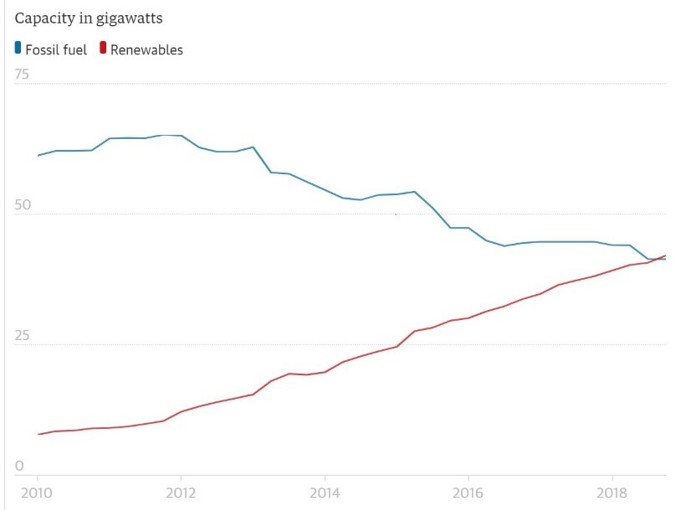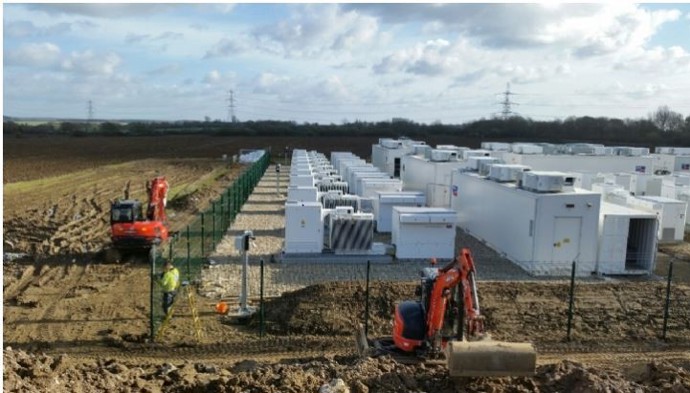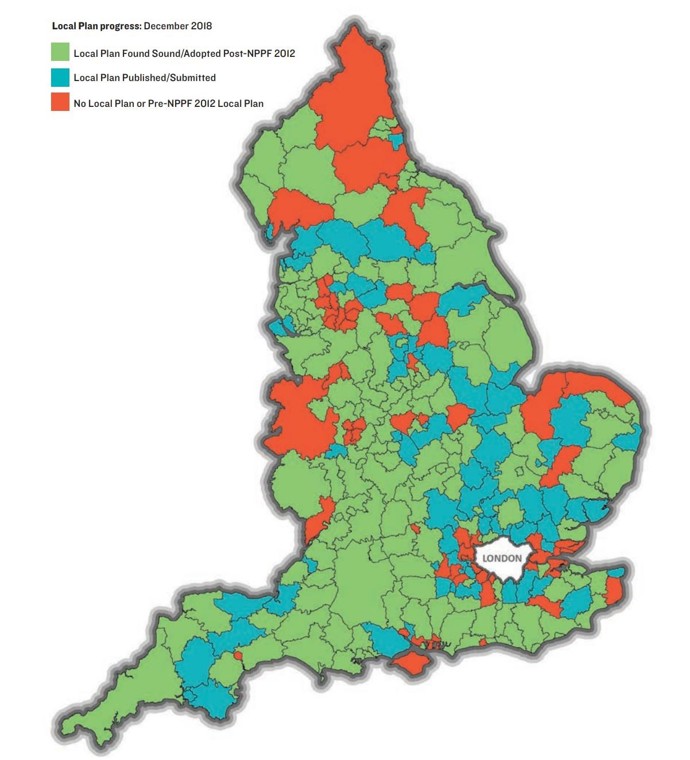A Changing Energy Mix
The UK’s energy mix is undergoing a process of rapid change in response to the global ambition to drastically limit global warming this century. The dependence on traditional methods of energy production is decreasing, and renewable energy is growing rapidly as a source of power generation. The capacity of renewable energy overtook fossil fuels in the UK for the first time ever in 2018 (Figure 1).
Figure 1 Renewable Energy Capacity Has Overtaken Fossil Fuels in the UK

Source: Guardian Graphic, Imperial College London, Drax (6th November 2018)
However, an increasing reliance on intermittent renewables such as wind and solar energy provision can create problems. As we make the switch to a more intermittent and less flexible low carbon generation mix, there is an emerging need to ensure that energy supply is resilient. Planning has a vital role to play in facilitating the provision of energy infrastructure in a timely way to ensure a consistency of supply.
This blog will explore how the planning system can strengthen its enabling role both at national and local level, with battery storage providing an important emerging technology to support the diversification of the energy market.
What we mean with battery storage?
Back-up energy facilities, such as battery storage energy plants, are emerging as potentially crucial elements of the UK’s energy mix, as excess energy can be stored and released during peak demand, or when renewable sources are not generating enough energy to meet demand.
Importantly, battery storage facilities have two key characteristics:
- They can provide back-up electricity in seconds, as opposed to gas plants which can take more than 40 minutes to supply electricity when called upon.
- They have an ability to operate with a significantly lower carbon footprint than conventional back-up generation plants (i.e. they do not produce emissions)[1].
Figure 2 battery storage Facility in the UK

Source: Edie.net (Edie Newsroom - 15th January 2019)
Battery Storage facilities are rapidly gaining market share and acceptance due to advances in their design, improved efficiency and lifespan. It is expected that this growth will continue, with a clear demand emerging in the market (coal energy production is expected to be phased out by 2025
[2]).
For Battery Storage developments to become mainstream components of the energy mix and maximise their potential, support is needed from the planning system to boost the quantity of these schemes and speed up their delivery.
What changes are proposed in National Policy?
Large-scale storage projects with a generating capacity of more than 50MW are currently considered under the Nationally Significant Infrastructure Projects (NSIP) regime, introduced by the Planning Act 2008, with smaller schemes decided by Local Planning Authorities (LPAs).
At national level in England, the way energy storage projects are assessed by the planning system has been the focus of a recent Government consultation titled ‘The treatment of electricity storage within the planning system’, which closed on 25th March 2019. The Department for Business, Energy and Industrial Strategy’s (BEIS) consultation sought to determine how best it can alter planning regulatory frameworks to support developers and businesses seeking to build energy storage facilities in England.
Specifically, the consultation aimed to gather opinions on the following proposals:
- Retaining the 50MW NSIP capacity threshold that applies to standalone storage projects; and,
- Amending the Planning Act 2008 to establish a new capacity threshold for composite projects including storage and another form of generation, such that composite projects in England would fall into the NSIP regime where either its capacity, excluding any electricity storage, is more than 50MW or the capacity of any electricity storage is more than 50MW.
The government states that findings so far indicate that the 50MW capacity threshold, “does not in itself distort storage developers’ sizing and investment decisions to a significant degree.”
However, it has been argued within the development industry that the threshold cap is currently impeding development of standalone Battery Storage schemes, and actively persuading developers to reduce the size of their proposals below 50MW. With the current pace of technological change, and the size of even the smallest schemes increasing, a continuation of this cap is clearly unsustainable.
It is also considered that removing this threshold cap could help to considerably improve the time taken to determine these schemes, and in the process significantly reduce associated costs.
The amendment to establish a new capacity threshold for composite projects would mean that a generating station would be determined under the local planning regime, where the capacity of both the storage and non-storage elements are less than 50MW individually. This could have positive implications if developers are encouraged to apply for composite schemes as a result, as these co-located projects bring significant benefits to the energy system by maximising the output and operational efficiency of projects.
It will be interesting to see the next steps the Government will take following the consultation, which could help shape the immediate future of Battery Storage’s treatment by the planning system. Nevertheless, LPAs need to start considering these matters now in their emerging local plans, as the provision of energy infrastructure and security of supply are vitally important elements for the development sector.
Local Plans: unfit for purpose?
The main pre-requisite for Battery Storage schemes is a connection to the electricity grid, and the locational requirements of such schemes present a significant constraint for their widespread implementation. This is because a storage facility must either be developed within close proximity to an existing power plant or sub-station with spare capacity, or brought forward alongside renewable energy infrastructure.
Currently, local plans provide nowhere near enough support to effectively enable implementation, and are largely ill-equipped to efficiently deal with the requirements of this emerging technology. LPAs must consider the way their local plans approach Battery Storage development, with particular regard to increasing delivery through the following actions:
-
Increasing the take-up of standalone schemes. This could potentially be improved through specific policies written into local plans, to provide an incentive to support their implementation; and
-
Promoting the integration of energy infrastructure schemes alongside new housing or employment developments. This could allow storage facilities to be delivered in tandem with renewable energy generation facilities.
Scope certainly remains to improve and maximise the ability of the planning system to help deliver these facilities on a widespread scale. Though an ability to improve delivery also relies somewhat on LPAs having an up-to-date, ‘modern’ local plan in place, with many LPAs across England yet to adopt innovative policies in this field.
This particular issue is highlighted in Figure 3 below, which illustrates local plan status post- original NPPF (2012). Just over 55% of LPAs have a post-NPPF 2012 plan in place as of December 2018.
Figure 3 Local Plan Status post-NPPF 2012 by LPA as at 31st December 2018

Source: Lichfields analysis
Without such innovation emerging from local plans, the delivery of standalone schemes, or integrated energy generation and storage facilities, is unlikely to come forward at the required rate. The local plan process simply cannot keep up with the current pace of technological change, and the UK cannot afford to get left behind in this regard.
To fully benefit from local energy storage, LPAs need to quickly consider the role their local plans can play in harnessing the rewards this technology can deliver.
Conclusions
As we move towards a flexible, de-centralised and de-carbonised energy system, the provision of localised energy infrastructure is vital, particularly through initiatives such as Battery Storage which bring numerous benefits.
The ability to provide electricity at short-notice in response to local demand is more important than ever before. The planning system must do all it can to help facilitate a general mainstreaming and the implementation of localised energy infrastructure. Currently, the majority of local plans are silent on these matters which is not helping the diversification of the energy market.
A widespread uptake of forward-thinking local plans, which directly support the diversification of the energy market, is essential in delivering the required change to help ‘keep the lights on’.
[1] Science for Environment Policy: Towards the battery of the future (September 2018)
[2] Reuters: Britain outlines plans for 2025 coal-power phase out (January 2018)






